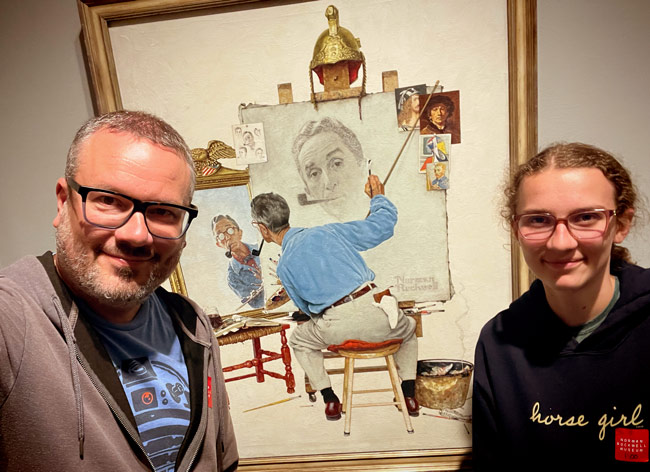
I used to think art was art, and even though everyone had a different style, artists were all on the same team. It took art school to re-educate me.
I discovered there were two main groups. One was the fine artists. The other group consisted of illustrators and graphic designers, of which I was a part. We were seen as second-class citizens, sellouts willing to take money to create whatever someone else wanted us to make. Many of the fine artists saw themselves as more artistically pure because they were creating art for art’s sake, achieving self-fulfillment, and bringing about social change. They, too, sold their work, but often to lesser success.
One of my painting teachers had a not-so-veiled disdain for the illustrators in his class. (Or maybe just me.) He had a particular distaste for Norman Rockwell, who has always been one of my favorites. In his time, Rockwell was one of the most well-known and financially successful artists, but alas, was firmly in the camp of illustrator, and therefore a money-grubbing capitalist in the eyes of my teacher, who also criticized Rockwell’s saccharine subject matter.
Norman Rockwell was known for painting scenes of idealized Americana, which the public adored. Only recently did I learn that Rockwell himself was well aware of this criticism. Far from being naive, he acknowledged his paintings were sentimental and idealized. He knew the world wasn’t perfect; he simply painted it as he wished it to be.
In his later years, as the civil rights movement was picking up steam, Rockwell did a series of paintings on race relations. I had a chance to see some of them up close at the Norman Rockwell Museum in Stockbridge, Massachusettes. They are a bit of a departure in theme but retain his trademark style and knack for engaging storytelling. (This is my favorite.) President Obama hung “The Problem We All Live With” in the White House, which depicts six-year-old Ruby Bridges entering the all-white William Frantz Elementary School, escorted by four US marshals.
I also learned that Norman Rockwell succeeded where President Franklin D. Roosevelt could not. FDR gave a speech about the Four Freedoms in order to gain support for the war effort. They were powerful ideas but didn’t capture the imagination of the American people until Rockwell turned them into emotional paintings that helped raise tons of money for war bonds.
I can’t help but wonder if Norman Rockwell had a bigger impact on America than any other artist working at the time, “fine art” or otherwise, simply because he had the trust of so many millions of Americans. In the days long before social media, he was one of the few artists who was truly known and had a following of millions of middle-class Americans, the backbone of the country. Perhaps that following, and the goodwill he had built with them, allowed him to lead them in some new ways of thinking.
Not bad for a lowly illustrator.
So what lessons are here for us?
First of all, I admire that Rockwell painted the world the way he wanted it to be. A better world always starts with a vision. Just as John F. Kennedy—a contemporary of Rockwell’s who was the subject of his final Saturday Evening Post cover—cast a vision of the moon landing before there was any realistic proof that we could do it, Rockwell offered up a positive aspiration of what could be. His paintings may not have reflected reality per se, but they served as a light to guide his viewers to an ideal to strive for.
We live in a world with lots of problems. Showing the world an example of how to make it better, through your actions, words, or work is always an admirable pursuit.
Secondly, Norman Rockwell was very talented. So are you. You will encounter no small amount of people in your life who are happy to tell you that you’re doing something wrong. They’ll criticize your reason for making art or how you make it. The way you approach your career. Market your services. Decorate your home. Dress. Vacation. Parent. Teach. Worship. They will give you a million reasons why being you isn’t good enough.
Be you anyway.
Your way of doing things might be just what the world’s been waiting for.
 I wonder…what’s something people have criticized about you that seems to be working out pretty well?
I wonder…what’s something people have criticized about you that seems to be working out pretty well?